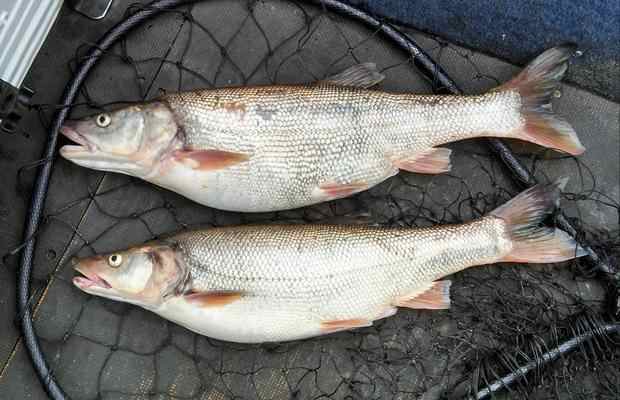forum
library
tutorial
contact

Anglers Can Earn Money
Fishing for Northern Pikeminnow
by Matthew Nesbit
Tri-City Herald, June 4, 2014
|
the film forum library tutorial contact |

|
Anglers Can Earn Money
by Matthew Nesbit
|
 Living in such close proximity to the Columbia and Snake rivers, you've probably heard about them -- fish that are worth money.
Living in such close proximity to the Columbia and Snake rivers, you've probably heard about them -- fish that are worth money.
Perhaps you've even heard about that fish your neighbor caught that was worth $500. Who are these mysterious money fish?
Meet the Northern Pikeminnow, formally known as Squawfish.
The pikeminnow is a piscivore (fish eater) and they have adapted all too well to the dam system, specifically the vulnerability it creates for juvenile salmon. Pikeminnow became so abundant and efficient in exploiting juvenile salmon that fishery managers implemented the Sport Reward Fishery program in 1990, paying anglers to catch them.
Each spring and summer, millions of juvenile salmon and steelhead, both wild fish and those released by hatcheries, migrate downstream to the ocean. These juvenile fish are the foundation for adult salmon returns. In short, the more baby salmon that make it to the ocean, the more adult salmon we will have returning from the ocean and fueling our fisheries. Thus voracious predators picking off baby salmon left and right is not an ideal situation for salmon populations!
The numbers coming out of the Sport Reward Fishery are astounding, both in the number of pikeminnow caught and the money paid out to some of the top anglers. In 2014, for instance, 164,000 Pikeminnow were turned into reward stations during the May 1 to Sept. 30 season. The top angler made $74,000!
The reward program payments are designed to push anglers to catch more and more fish throughout the season. The more you catch, the more money you get per fish. The program has upped the payments significantly this year in an effort to keep people interested and motivated.
The first 25 fish are worth $5 per fish; 26-200 fish pays $6 and when you've caught more than 200 fish they are worth $8 apiece. This means that anglers will make almost an extra $900 for their first 400 fish this year compared to last. There are also specially tagged fish worth $500 each.
So you want to be a professional pikeminnow fisherman, eh? People say it all the time, "Those guys make a lot of money, I should do that." I've got news for you. Those guys aren't fishing, they're working.
I know one professional pikeminnower quite well; for the sake of anonymity let's just call him Wayne.
In the weeks leading up to the season Wayne can't think about anything else, he's obsessed. And while May 1 finds thousands of fishermen flocking to McNary or Ice Harbor dams in search of Spring Chinook, the "Wayner" is wetting a line for pikeminnow.
He'll fish most of the day for the first month or two of the season. When it gets too hot, he'll night fish or wake up at o'dark thirty to fish in the mornings. That doesn't sound too bad, but when you consider the fact that during the hottest days of the year, when temps hit triple digits, many pikeminnow fisherman head out to fry themselves in the scorching sun. Why?
Hot temperatures mean Mormon crickets, a favorite pikeminnow bait, will swarm in the fields around the Tri-Cities. So after waking up before daybreak and fishing until temperatures are at their highest, you drive into the fields and chase crickets for a few hours, returning home with your bucket of crickets for bait the next day. Then, not only are you a professional pikeminnow fisherman, but you are also a cricket rancher of sorts.
A few years back Wayne earned an "honorary degree" as an entomologist, perfecting his cricket capturing, transporting and housing studies after months of trial and error. Last year persistence paid off, when he caught three tagged pikeminnow worth $500 each in the same day. That's a record that could stand until the end of time, since most anglers only catch one tagged fish for roughly every thousand pikeminnow they turn in.
"Those guys don't get much sleep," said local state Fish & Wildlife biologist John Hone, referring to the handful of diehard anglers that make tens of thousands of dollars each year fishing for pikeminnow.
Hone told a story of one fisherman who has slept in his boat for the entire season so far this year -- that's going on 40 days folks!
John offered some inspiring words for those of you who might be looking to only make a few bucks -- as opposed to an entire years' salary -- off the wily pikeminnow.
"The Northern Pikeminnow is an aggressive predator, they're not hard to catch but they are hard to find on a day-to-day basis." Hone said.
The new reward payment tiers were designed to motivate people to stay persistent, as it's easy to get frustrated after a day or two in the summer heat without much success.
An invaluable resource is www.pikeminnow.org, an easy-to-navigate website with links to regulations, catch data, fishing maps, turn-in stations, reports and more.
Hone and Tim Histand will give a free clinic from 6-7 p.m. June 11 at Sportsman's Warehouse in Kennewick. Tim is one of the top anglers each year and it's very rare that a top angler would share any of his money-making tips, much less present to the general public.
learn more on topics covered in the film
see the video
read the script
learn the songs
discussion forum
